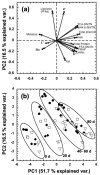Ripening Changes of the Chemical Composition, Proteolysis, and Lipolysis of a Hair Sheep Milk Mexican Manchego-Style Cheese: Effect of Nano-Emulsified Curcumin
- PMID: 34359451
- PMCID: PMC8306841
- DOI: 10.3390/foods10071579
Ripening Changes of the Chemical Composition, Proteolysis, and Lipolysis of a Hair Sheep Milk Mexican Manchego-Style Cheese: Effect of Nano-Emulsified Curcumin
Abstract
The influence of nano-emulsified curcumin (NEC) added to the hair sheep milk, prior to cheese-making, on the chemical composition, lipolysis, and proteolysis of manchego-style cheeses were evaluated throughout 80 days of ripening. The addition of NEC to the milk resulted in cheeses with the same moisture content (42.23%), total protein (23.16%), and water activity (0.969) (p > 0.05). However, it increased the fat and ash levels from 26.82% and 3.64% in B 10 ppm to 30.08% and 3.85% in C 10 ppm, respectively, at the end of the ripening (p < 0.05). The total phenolic content and antioxidant activity of experimental cheeses increased during ripening, and the fatty acid groups showed significant changes occurred to a greater extent in the first days of ripening (p < 0.05). The lipolysis increased consistently in all cheeses until day 40 of ripening, to decrease at the end, while proteolysis increased during all ripening time in all samples (p < 0.05); the addition of NEC did not alter the primary proteolysis of manchego-style cheeses, but it modified secondary proteolysis and lipolysis (p < 0.05). Principal component analysis was useful for discriminating cheeses according to their chemical composition and classified into four groups according to their ripening time. This research highlights the potential of CNE to fortify dairy foods to enhance their functionality.
Keywords: Pelibuey ewes; curcumin; lipolysis; manchego cheese; proteolysis; ripening.
Conflict of interest statement
The authors declare no conflict of interest.
Figures




References
LinkOut - more resources
Full Text Sources
Research Materials
Miscellaneous

